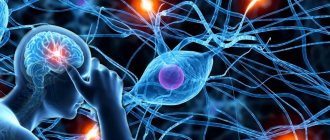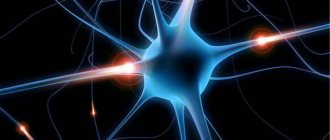From the point of view of the physiology of higher nervous activity, emotion means an urge to action. The word is derived from the Latin verb “emovere” - I excite. In relation to emotion, the object of excitation is the cerebral cortex, which generates a mental reaction. According to the teachings of Academician Anokhin, any motivation is generated by emotion. Moreover, before the launch of a functional system, any emotion is considered negative until a positive result is achieved. If the goal turns out to be unattainable, the emotion will remain negative. When a person’s nervous system is weakened, emotional lability occurs, which is characterized by an instant reaction to any stimuli. It doesn’t matter at all what sign it is – “plus” or “minus”.
An emotionally labile person reacts equally sharply to positive and negative stressors. Changes in the situation cause an instant, violent reaction. A person cries with happiness or, conversely, resentment gives rise to hysterical laughter. This is where emotional lability manifests itself, as opposed to stability. The opposite state is called rigidity in psychology, and emotional flatness in psychiatry. Lack of emotions is much more dangerous for human health. Loss of motivation leads to exhaustion faster than an explosion of emotions.
Causes of emotional lability
Disorders in the expression of emotions occur against the background of disturbances in the functioning of the central nervous system. Provoking factors are socio-psychological negative influences and somatic diseases that indirectly or directly affect the functions of the central nervous system. The most common causes of emotional instability include:
- Prolonged stress.
Prolonged psycho-emotional stress depletes the body's ability to self-regulate. Affective lability is formed during periodic lack of sleep, intense physical and mental stress, and interpersonal conflicts. - Psychotraumatic situation.
Emotional instability develops as a reaction to an unexpected adverse event. The cause could be the death of a loved one, divorce, or an act of violence. - Endocrine imbalance.
Hormones affect the functioning of parts of the brain responsible for emotions and behavior control. Emotional instability is often observed in adolescents during puberty, pregnant women, people with pathologies of the thyroid gland and adrenal glands. - Vascular diseases.
Risk factors are hypotension, hypertension, cerebral atherosclerosis, cerebral form of Buerger's disease. Affective disorders are based on changes in the blood supply to nervous tissue - Neurological diseases.
Emotional lability is a symptom of organic brain damage. It is found in traumatic brain injuries, tumors, neuroinfections, and severe intoxications. - Mental disorders.
The instability of emotions accompanies most neuroses, psychopathy, and dementia. It is a central symptom in emotionally labile disorder.
Methods of correction and treatment
Emotional lability and its treatment are an important aspect in the formation of the personality of children. Adults also require correction, since the pathology does not disappear on its own. Before working with the nervous system, it is necessary to establish the cause of the symptoms.
If this is regular stress, you will have to find its root cause and try to eliminate it. If this is a disease of the cerebral cortex, endocrine or nervous system, therapy with a psychiatrist will be only a small part of the treatment program. In any case, it is worth undergoing an examination of the body and contacting a psychologist, psychiatrist or psychotherapist.
Doctors prescribe special medications for adults that can control their emotional state and suppress outbursts of anger, aggression, and expressiveness. Treatment of childhood syndrome occurs differently. Most medications are intended only for adult patients, but other methods of work are used with children.
Emotional lability syndrome in children - is it self-expression or pathology? A character trait can be corrected - this is the responsibility of the parents. If a pathology is detected, specialist intervention is required. Drugs are almost never prescribed to children, since taking them at a young age can lead to serious consequences. If treatment is unavoidable, the doctor gives preference to medications based on herbal ingredients.
To a greater extent, parents influence the correction of emotional lability in a child. Adults need to explain how to control emotions, cope with failure and overcome difficulties. It is upbringing that can instill in a child self-control, calmness and adequacy from early childhood.
Pathogenesis
Emotions reflect a person’s direct attitude towards objects and situations. Their expression and direction are an important component of the process of understanding the surrounding world and one’s own state. Increased emotional lability is a violation of the intensity of affective experiences. It occurs when there is an imbalance in the processes of excitation and inhibition in the nervous system with a predominant shift towards hyperactivation. Neural signal transmission accelerates, focus decreases. The severity of the emotional response becomes inadequate to the strength of the stimulus. At the same time, the content and direction of the experiences correspond to the situation. For example, a short separation from a loved one causes an attack of sobbing and crying that is uncontrollable.
Forms of pathology
Pathology in the form of emotional lability is of two types:
- border;
- impulsive.
The borderline type is expressed in apathy, frustration, and indifference. A person susceptible to this type of lability expresses emotions weakly and inactively. Increased anxiety and absent-mindedness may occur.
The impulsive type is the opposite of the borderline type. People suffering from this type of pathology are characterized by a negative mood, anger, and addiction to bad habits. Auto-aggression can result in suicidal tendencies, so it is important for such people to promptly contact specialists for help in solving problems.
Symptoms of emotional lability
The main manifestations are excessive emotionality, frequent mood swings. The most noticeable is increased tearfulness. Crying is provoked by sad and pleasant events - watching a melodrama, watching a child play, or having a sincere conversation. Reactions of this type are characteristic of vascular pathologies, organic brain diseases, and asthenic syndrome. Outbursts of anger and rage are uncontrollable, but quickly fade away. They arise in everyday everyday situations, accompanied by frustration and dissatisfaction. They often become the cause of impulsive aggressive and auto-aggressive actions - in a fit of anger, patients shout at children, bang their fists on the table, hurt themselves, and provoke scandals.
Another common symptom is sensitivity to objections, criticism, rudeness, and intolerance of the opinions of others. An uncontrollable desire arises to prove one’s own rightness, to establish justice, to argue. At the height of affect, anger can suddenly give way to laughter or crying. Patients are characterized by increased fatigue, weakness, and decreased performance. Sleep after experiences is superficial, restless, with frequent awakenings. Difficulty concentrating and rapid mood changes affect the ability to get involved in any activity and achieve goals. Patients are often in search of their calling and try different types of activities. They lack persistence and focus.
Emotional lability is characterized by frequent mood swings
Symptoms of pathology
Emotional lability: what is it in adults? Pathology is accompanied by symptoms that can be used to determine the presence of problems. The very definition of the term suggests that the symptoms express emotional instability. This manifests itself in an inadequate reaction to familiar events.
Most often, people with the syndrome react sensitively to touching films and books, emotional conversations, small children and animals. They often cry, but they themselves cannot explain why. Yes, kittens and puppies are cute, but not to the point of tears.
Aggression and self-aggression also take place. In most cases, they flare up sharply and subside just as abruptly. This symptom is considered a defensive reaction when people try to hide their problems. An unobtrusive question about your well-being or mood can lead to inappropriate shouting and attempts to avoid answering.
Frequent mood swings are a clear symptom. A person can enthusiastically play a game for 20 minutes, and a minute later decide that it is all nonsense and a waste of time. He may study the cinema's repertoire with interest and plan to attend a show, and later give up and burst into tears.
The next symptom is expressed in passion for the task. For example, a constant search for a new hobby and a rapid loss of interest indicate emotional lability. Immersion in the study of the history of Ancient China, a quick change of this hobby to cross-stitching, and then to football - all these are symptoms of pathology. Let us highlight the main symptoms of emotional lability syndrome:
- frequent mood changes;
- immoderate passion;
- aggression;
- auto-aggression;
- increased tearfulness.
All these symptoms are characteristic of each individual at different periods of life. If you notice them, there is no need to immediately sound the alarm. It is worth thinking about help when they are expressed quite clearly and are repeated regularly.
Complications
If left untreated, emotionally labile patients experience constant mental stress and fatigue, and provoke conflicts with others. Often this condition leads to depression, suicidal thoughts, and isolation from society. Nervous exhaustion is manifested by chronic fatigue, development or exacerbation of somatic diseases. A decrease in motivation and focus prevents patients from independently seeking medical and psychological help. When complications develop, they need organizing and stimulating help from relatives.
Diagnostics
When examining patients with emotional lability, the main attention is paid to the causes of this symptom and the determination of the underlying disease. The presence of affective instability is identified by a psychiatrist, and consultations with somatic specialists are prescribed for differential diagnosis: therapist, neurologist, endocrinologist, cardiologist. Specific research methods are:
- Clinical conversation.
Patients often talk about increased tearfulness, outbursts of anger, irritability, and the inability to control affective reactions, despite understanding that they are exaggerated and unreasonable. Often these symptoms are accompanied by quarrels at work and at home, general depression, and depression. - Observation.
A conversation with a doctor is a stressful situation for patients, and therefore causes increased tension. Patients react too emotionally to the specialist’s questions: they cannot find words from excitement, cry, and easily succumb to conflict provocation. They are restless in behavior, they perform obsessive actions to relieve tension (they shake their legs, tap a pencil on the table, finger the edge of their clothes). - Psychodiagnostics.
The specialist performs a study of the emotional and personal sphere using complex questionnaires (SMIL, Cattell's 16-factor questionnaire, Eysenck questionnaire), as well as projective techniques (drawing of a person, method of color choices). Based on the results, the psychologist assesses the presence of emotional lability, depression, and identifies the likelihood of personality disorders and neuroses. If asthenic syndrome is suspected, conducts tests to assess performance (correction test, Schulte tables).
How does this translate in life?
There are a number of clear signs by which one can recognize the emergence and “emergence” of emotional lability:
- The first sign is the inability to cope with difficulties , even the most insignificant ones. A person in advance, without even trying to do something, falls into melancholy and despondency.
- Outbursts of affect - explosions of hysteria, yelling, crying, laughter, anger, resentment... all in an exaggerated form and suddenly.
- A person between outbursts of affects is sluggish, apathetic.
- A tearful state occurs in most cases after “emotional outbursts.”
- “Close-heartedness” - a person reacts very sharply to any situation, especially to a situation that is negative for him for some reason.
- Acute reaction to criticism addressed to oneself , especially if the criticism is negative. A person suffering from pathology cannot loyally, calmly and adequately perceive information about himself.
- Assessment of behavior, assessment of actions, assessment of skills , assessment of life, both personal and public, becomes a reason for aggression or hysteria .
- There is no constructive thinking, no logically constructed actions . All life is built on a chaotic reaction to what is happening: outbursts of affect, periods of melancholy and despondency.
- May be accompanied by diseases of internal organs .
Based on the above symptoms, you can already visually imagine what a labile person looks like. A type with clear, fast and clearly expressed facial expressions, constant sharp movements in space, quickly reacting to any external signals (sharp sound, clap, beam of light).
Treatment of emotional lability
To restore the stability of the emotional-volitional sphere, it is necessary to determine the underlying disease and carry out its comprehensive treatment. Thus, etiotropic therapy can be carried out by a psychiatrist, neurologist, endocrinologist, therapist, cardiologist and doctors of other specialties, and include conservative and surgical procedures. Specific treatment methods include:
- Individual psychotherapy.
Sessions are aimed at identifying internal conflicts, fears, correcting self-perception, restoring control over one’s own body and its reactions. Methods of cognitive behavioral therapy, auto-training with relaxation, and art therapy are used. - Group psychotherapy.
Attending trainings makes it possible to improve the social adaptation of patients, increase self-confidence, restore focus and motivation for activity. In the group, the patient masters the skills of effective communication, conflict resolution, and has the opportunity to observe and analyze the reactions of others. - Consulting.
The psychotherapist tells family members about the causes of emotional lability, characteristics of manifestations, and prognosis. Gives recommendations on how to respond to the patient's mood swings, how to adjust relationships and daily routine to speed up recovery. - Medication correction.
The use of drugs to reduce anxiety, tension, depression, and restore emotional calm is indicated. A psychiatrist prescribes tranquilizers, sedatives, antidepressants, and in case of severe behavioral disorders, antipsychotics in a minimal dosage.
Group psychotherapy
Prognosis and prevention
The prognosis depends on the course of the underlying disease, but a competent approach to treatment can always significantly improve the quality of life of patients and compensate for the symptoms of emotional disturbance with relaxation and self-regulation skills. The most effective method of prevention is the rational organization of work and rest schedules. Periods of intense mental work should be followed by physical activity (preferably in the fresh air). If you show signs of fatigue, you need to take a break and switch to another type of activity. Adequate sleep in the dark and proper nutrition are required.









